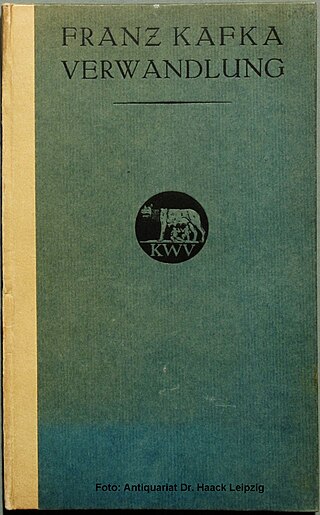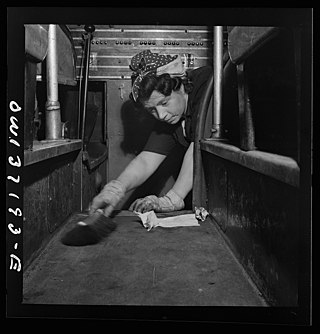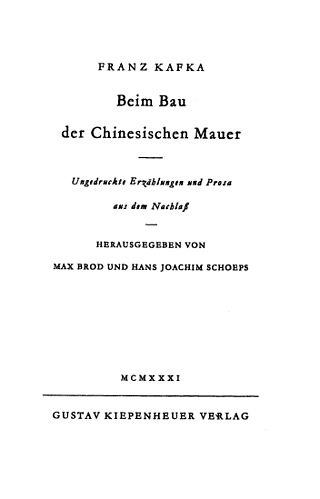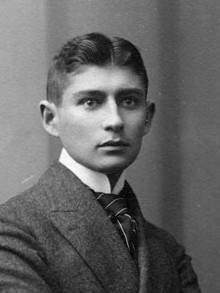Related Research Articles

Franz Kafka was a German-speaking Bohemian Jewish novelist and writer from Prague. He is widely regarded as one of the major figures of 20th-century literature. His work fuses elements of realism and the fantastic. It typically features isolated protagonists facing bizarre or surrealistic predicaments and incomprehensible socio-bureaucratic powers. It has been interpreted as exploring themes of alienation, existential anxiety, guilt, and absurdity. His best known works include the novella The Metamorphosis and novels The Trial and The Castle. The term Kafkaesque has entered English to describe absurd situations like those depicted in his writing.

Metamorphosis is a novella written by Franz Kafka and first published in 1915. One of Kafka's best-known works, Metamorphosis tells the story of salesman Gregor Samsa, who wakes one morning to find himself inexplicably transformed into a huge insect and subsequently struggles to adjust to this new condition. The novella has been widely discussed among literary critics, who have offered varied interpretations. In popular culture and adaptations of the novella, the insect is commonly depicted as a cockroach.

"In the Penal Colony" is a short story by Franz Kafka written in German in October 1914, revised in November 1918, and first published in October 1919. As in some of Kafka's other writings, the narrator in this story seems detached from, or perhaps numbed by, events that one would normally expect to be registered with horror. Internal clues and the setting on an island suggest Octave Mirbeau's The Torture Garden as an influence. The story is set in an unnamed penal colony and describes the last use of an elaborate torture and execution device that carves the sentence of the condemned prisoner on his skin as he slowly dies over the course of twelve hours. As the plot unfolds, the reader learns more and more about the machine, including its origin and original justification.

Amerika, (German working title Der Verschollene, "The Missing") also known as The Man Who Disappeared (Amerika), Amerika: The Missing Person and Lost in America, is the incomplete first novel by author Franz Kafka (1883–1924), written between 1911 and 1914 and published posthumously in 1927. The novel originally began as a short story titled "The Stoker". The novel incorporates many details of the experiences of his relatives who had emigrated to the United States. The commonly used title Amerika is from the edition of the text put together by Kafka's close friend, Max Brod, after Kafka's death in 1924. It has been published in at least three major English-language versions: as Amerika, translated by Edwin and Willa Muir (1938); as The Man Who Disappeared (Amerika), translated by Michael Hoffmann (1996); and as Amerika: The Missing Person, translated by Mark Harman (2008).

"The Judgment", also translated "The Verdict", is a short story written by Franz Kafka in 1912, concerning the relationship between a man and his father.
"A Report to an Academy" is a short story by Franz Kafka, written and published in 1917. In the story, an ape named Red Peter, who has learned to behave like a human, presents to an academy the story of how he effected his transformation. The story was first published by Martin Buber in the German monthly Der Jude, along with another of Kafka's stories, "Jackals and Arabs". The story appeared again in a 1919 collection titled Ein Landarzt.

Kafka on the Shore is a 2002 novel by Japanese author Haruki Murakami. Its 2005 English translation was among "The 10 Best Books of 2005" from The New York Times and received the World Fantasy Award for 2006. The book tells the stories of the young Kafka Tamura, a bookish 15-year-old boy who runs away from his Oedipal curse, and Satoru Nakata, an old, disabled man with the uncanny ability to talk to cats. The book incorporates themes of music as a communicative conduit, metaphysics, dreams, fate, and the subconscious.

A charwoman is an occupational term, referring to a paid part-time worker who comes into a house or other building to clean it for a few hours of a day or week, as opposed to a maid, who usually lives as part of the household within the structure of domestic service. A charwoman might work independently, often for cash in hand, or might come through an employment agency.

"The Great Wall of China" is a short story by Franz Kafka. While written in 1917, it was not published until 1930, seven years after his death. Its first publication occurred in Der Morgen, a German literary magazine. A year later, Max Brod included it in Beim Bau der Chinesischen Mauer, the first posthumous collection of short stories by Franz Kafka.

The Franz Kafka Prize is an international literary award presented in honour of Franz Kafka, the Jewish, Bohemian, German-language novelist. The prize was first awarded in 2001 and is co-sponsored by the Franz Kafka Society and the city of Prague, Czech Republic.

The Complete Stories of Franz Kafka is a compilation of all of Kafka's short stories. With the exception of three novels, this collection includes all of his narrative work. The book was originally edited by Nahum N. Glatzer and published by Schocken Books in 1971. It was reprinted in 1995 with an introduction by John Updike.

Franz Kafka's Diaries, written in German language between 1910-1923, include casual observations, details of daily life, reflections on philosophical ideas, accounts of dreams, and ideas for stories. Kafka’s diaries offer a detailed view of the writer's thoughts and feelings, as well as some of his most famous and quotable statements.

Dearest Father: Stories and Other Writings is a collection of writings by Franz Kafka translated by Ernst Kaiser and Eithne Wilkins with notes by Max Brod. The title derives from Kafka's Letter to His Father, which begins with this salutation. A translation of Dearest Father alone, with notes and an introduction by its translators, Hannah and Richard Stokes, was published in 2008.

Introducing Kafka, also known as R. Crumb's Kafka, is an illustrated biography of Franz Kafka by David Zane Mairowitz and Robert Crumb. The book includes comic adaptations of some of Kafka's most famous works including The Metamorphosis, A Hunger Artist, In the Penal Colony, and The Judgment, as well as brief sketches of his three novels The Trial, The Castle, and Amerika. The book also details Kafka's biography in a format that is part illustrated essay, part sequential comic panels.
"A Visit to a Mine" is a short story by Franz Kafka. The story is told by a narrator who is planning the drilling of a mine. It opens with orders from above to the workers around the mine. The narrator details the elaborate rank and file system among the workers. There are ten engineers and nine of them have specified functions. For example, one measures the area of the tunnel, while another follows him, preparing to drill. There is a suggestion that within the bureaucratic structure there is a lack of efficiency. At least one engineer serves to answer the question that "another does not want to ask." The story ends with the narrator and the other engineers, taking notes, inspecting, and measuring.
"A Common Confusion" is a short story by Franz Kafka. It was published posthumously in Beim Bau der Chinesischen Mauer. The first English translation by Willa and Edwin Muir was published by Martin Secker in London in 1933. It appeared in The Great Wall of China. Stories and Reflections.
"The Truth about Sancho Panza" is a short story by Franz Kafka. It was published in 1931, seven years after the death of Kafka. Max Brod selected stories and published them in the collection Beim Bau der Chinesischen Mauer. The first English translation by Willa and Edwin Muir was published by Martin Secker in London in 1933. It appeared in The Great Wall of China: Stories and Reflections.
"Shamefaced Lanky and Impure in Heart" is the title usually given to Franz Kafka's earliest surviving work of fiction, a short story that he wrote in 1902 and that has survived only because it was included in a letter to his friend Oskar Pollak.

Ottilie "Ottla" Kafka was the youngest sister of Franz Kafka. His favourite sister, she was probably also his closest relative and supported him in difficult times. Their correspondence was published as Letters to Ottla. She was murdered in the Holocaust.
"My Neighbor" is a short story by Franz Kafka. It was written in 1917 and published in 1931 in Berlin by Max Brod and Hans-Joachim Schoeps. The first English translation by Willa and Edwin Muir was published by Martin Secker in London in 1933. It appeared in The Great Wall of China. Stories and Reflections.
References
- Richard T. Gray, Ruth V. Gross, Rolf J. Goebel. A Franz Kafka encyclopedia. Greenwood Publishing Group, 2005.